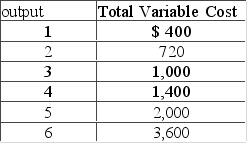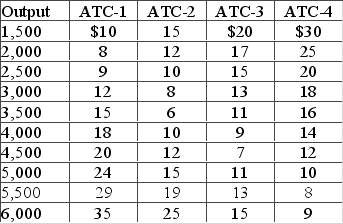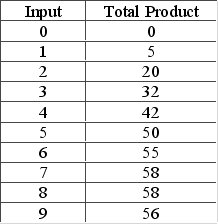A) marginal cost increases.
B) average fixed cost increases.
C) average total cost decreases.
D) average variable cost increases.
Correct Answer

verified
Correct Answer
verified
Multiple Choice
The first, second, and third workers employed by a firm add 24, 18, and 9 units to total product, respectively. Therefore, we can conclude that
A) marginal product of the third worker is 9.
B) the third worker has to work with poorer-quality tools and raw materials.
C) the firm will not want to hire more than three workers.
D) the first worker puts forth more effort than the second and third workers.
Correct Answer

verified
Correct Answer
verified
True/False
Normal profit is an implicit cost.
Correct Answer

verified
Correct Answer
verified
Multiple Choice
Which of the following statements is correct?
A) Average total cost is the difference between average variable cost and average fixed cost.
B) Marginal cost measures the cost per unit of output associated with any level of production.
C) When marginal product rises, marginal cost must also rise.
D) Marginal cost is the price or cost of an extra variable input (for example, an additional worker or machine) divided by its marginal product.
Correct Answer

verified
Correct Answer
verified
True/False
Average fixed costs diminish continuously as output increases.
Correct Answer

verified
Correct Answer
verified
Multiple Choice
When a firm doubles its inputs and finds that its output has more than doubled, this is known as
A) economies of scale.
B) constant returns to scale.
C) diseconomies of scale.
D) a violation of the law of diminishing returns.
Correct Answer

verified
Correct Answer
verified
Multiple Choice
The fixed cost of the firm is $500. The firm's total variable cost is indicated in the table.  The average total cost of the firm when 3 units of output are being produced is
The average total cost of the firm when 3 units of output are being produced is
A) $350.
B) $400.
C) $500.
D) $700.
Correct Answer

verified
Correct Answer
verified
Multiple Choice
When the total product curve is falling, the
A) marginal product of labor is zero.
B) marginal product of labor is negative.
C) average product of labor is increasing.
D) average product of labor must be negative.
Correct Answer

verified
Correct Answer
verified
Multiple Choice
Harvey quit his job at State University, where he earned $45,000 a year. He figures his entrepreneurial talent or forgone entrepreneurial income to be $5,000 a year. To start the business, he cashed in $100,000 in bonds that earned 10 percent interest annually to buy a software company, Extreme Gaming. In the first year, the firm sold 11,000 units of software at $75 for each unit. Of the $75 per unit, $55 goes for the costs of production, packaging, marketing, employee wages and benefits, and rent on a building. The normal profits for Harvey in the first year were
A) $5,000.
B) $160,000.
C) $220,000.
D) $150,000.
Correct Answer

verified
Correct Answer
verified
Multiple Choice
The following is cost information for the Creamy Crisp Donut Company. Entrepreneur's potential earnings as a salaried worker = $50,000 Annual lease on building = $22,000 Annual revenue from operations = $380,000 Payments to workers = $120,000 Utilities (electricity, water, disposal) costs = $8,000 Value of entrepreneur's talent in the next best entrepreneurial activity = $80,000 Entrepreneur's forgone interest on personal funds used to finance the business = $6,000 Creamy Crisp's explicit costs are
A) $286,000.
B) $150,000.
C) $94,000.
D) $156,000.
Correct Answer

verified
Correct Answer
verified
Multiple Choice
At any level of output.
A) average variable cost will exceed average total cost in the short run.
B) marginal cost will exceed average variable cost by the level of average fixed cost.
C) average variable cost will exceed average fixed cost by the level of average total cost.
D) average total cost will exceed average variable cost by the level of average fixed cost.
Correct Answer

verified
Correct Answer
verified
Multiple Choice
Assume that the only variable resource used to produce output is labor.  Refer to the provided table. With diminishing marginal returns, if the firm hires seven units of labor, which of the following numbers would most probably be the total product?
Refer to the provided table. With diminishing marginal returns, if the firm hires seven units of labor, which of the following numbers would most probably be the total product?
A) 40
B) 39
C) 38
D) 37
Correct Answer

verified
Correct Answer
verified
Multiple Choice
When producing 8 units of output, average fixed cost is $12.50 and average variable cost is $81.25. Total cost at this output level is
A) $93.75.
B) $97.78.
C) $750.
D) $880.
Correct Answer

verified
Correct Answer
verified
Multiple Choice
The following is cost information for the Creamy Crisp Donut Company. Entrepreneur's potential earnings as a salaried worker = $50,000 Annual lease on building = $22,000 Annual revenue from operations = $380,000 Payments to workers = $120,000 Utilities (electricity, water, disposal) costs = $8,000 Value of entrepreneur's talent in the next best entrepreneurial activity = $80,000 Entrepreneur's forgone interest on personal funds used to finance the business = $6,000 Creamy Crisp
A) has lower implicit costs, including a normal profit, than its explicit costs.
B) is earning a normal profit but not an economic profit.
C) is earning an economic profit.
D) is suffering an economic loss, when implicit costs are considered.
Correct Answer

verified
Correct Answer
verified
Multiple Choice
If in the short run a firm's total product is increasing, then its
A) marginal product must also be increasing.
B) marginal product must be decreasing.
C) marginal product could be either increasing or decreasing.
D) average product must also be increasing.
Correct Answer

verified
Correct Answer
verified
Multiple Choice
Plant sizes get larger as you move from ATC-1 to ATC-4.  In the long run, the firm should use plant size ATC-3 for what level of output?
In the long run, the firm should use plant size ATC-3 for what level of output?
A) less than 3,000
B) 3,000 to 3,500
C) 4,000 to 4,500
D) 5,000 to 5,500
Correct Answer

verified
Correct Answer
verified
Multiple Choice
If total fixed cost is $200, total variable cost is $600, and total product is 4 units, then average total cost must be
A) $200.
B) $250.
C) $800.
D) $3,200.
Correct Answer

verified
Correct Answer
verified
Multiple Choice
Variable costs are
A) costs that remain to be paid even if the firm shuts down temporarily.
B) costs that change every day or every month.
C) costs that change with the level of production.
D) changes in total cost due to the production of an additional unit of output.
Correct Answer

verified
Correct Answer
verified
Multiple Choice
The question is based on the following table, which provides information on the production of a product that requires one variable input.  Diminishing marginal returns sets in with the addition of the
Diminishing marginal returns sets in with the addition of the
A) first unit of input.
B) second unit of input.
C) third unit of input.
D) fourth unit of input.
Correct Answer

verified
Correct Answer
verified
Multiple Choice
In the long run,
A) all costs are variable costs.
B) all costs are fixed costs.
C) variable costs equal fixed costs.
D) fixed costs are greater than variable costs.
Correct Answer

verified
Correct Answer
verified
Showing 41 - 60 of 307
Related Exams